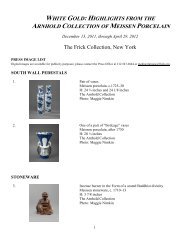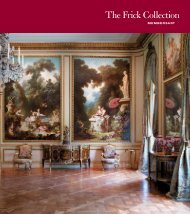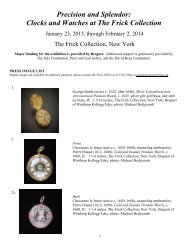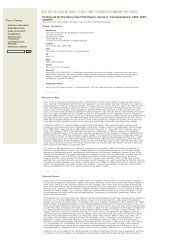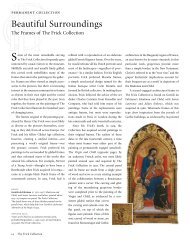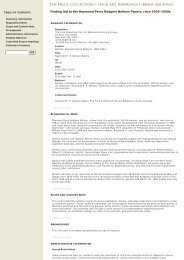ARCHIVED PRESS RELEASE THE FRICK COLLECTION
ARCHIVED PRESS RELEASE THE FRICK COLLECTION
ARCHIVED PRESS RELEASE THE FRICK COLLECTION
Create successful ePaper yourself
Turn your PDF publications into a flip-book with our unique Google optimized e-Paper software.
<strong>ARCHIVED</strong> <strong>PRESS</strong> <strong>RELEASE</strong><br />
from<br />
<strong>THE</strong> <strong>FRICK</strong> <strong>COLLECTION</strong><br />
1 EAST 70TH STREET • NEW YORK • NEW YORK 10021 • TELEPHONE (212) 288-0700 • FAX (212) 628-4417<br />
Quincentenary of the Birth of Parmigianino Marked by<br />
Only One Exhibition in the United States<br />
A Beautiful and Gracious Manner: The Art of Parmigianino<br />
January 27 through April 18, 2004<br />
New York’s Frick Collection is the only museum in the United States to present an<br />
exhibition celebrating the 500 th anniversary of the birth of Parmigianino<br />
(1503–1540). Born in Parma and known as Parmigianino after his native city,<br />
Girolamo Francesco Maria Mazzola lived thirty-seven years, and his career<br />
spanned twenty. Yet in that brief time, the quantity, variety, and sheer beauty of his<br />
drawings came to exemplify the art of draftsmanship. Almost one thousand<br />
drawings by this prolific artist survive, and his graphic output represents the range<br />
of Renaissance practice in all its forms and media. Less than twenty years after his<br />
death, the humanist Ludovico Dolce stated, “Parmigianino endowed his creations<br />
with a certain beauty which makes whoever looks at them fall in love with them.<br />
Parmigianino (1503–1540)<br />
Saturn and Philyra, c. 1531–35<br />
Pen and brown ink and brown wash with white<br />
So delicate and accurate was his draftsmanship that every drawing of<br />
heightening over black chalk underdrawing<br />
11 x 8.1 cm<br />
his…astonishes the eyes of the beholder.” A Beautiful and Gracious Manner:<br />
Royal Collection © 2003 Her Majesty Queen<br />
Elizabeth II<br />
The Art of Parmigianino is organized by the National Gallery of Canada,<br />
Ottawa, and presents fifty-one drawings that span the artist’s career and illustrate the genius of his achievement.<br />
These sheets are accompanied by seven jewel-like oil paintings, similar to them in scale and refinement, which<br />
evoke the correspondences between Parmigianino’s fluent handling of oil and the graphic media. Parmigianino<br />
was the first Italian painter to experiment with printmaking, and the dozen prints included in the exhibition feature<br />
his pioneering etchings that were so highly prized by Renaissance collectors for their inimitable choreography of<br />
line. The exhibition also commemorates Parmigianino’s gifts as a portraitist by presenting swiftly executed<br />
sketches and two works in oil, notable, as are all his portraits, for their acutely observed detail and enigmatic<br />
psychology. The sitters personify the rarified courtly cultures in which Parmigianino worked and represent the kind
of patrons who esteemed the artist for his beautiful and gracious manner. The exhibition’s selection of drawings<br />
was chosen from the widest range of international public and private collections to provide the most outstanding<br />
examples representing the four key periods in Parmigianino’s brief career: his beginnings in Parma (1520–24); his<br />
sojourn in Rome (1524–27); his years in Bologna (1527–30); and his return to Parma (1530–40). Curated by David<br />
Franklin, Deputy Director and Chief Curator, National Gallery of Canada, and coordinated at the Frick by<br />
Associate Curator Denise Allen, the exhibition is accompanied by a fully illustrated catalogue. Presentation of the<br />
exhibition in New York is made possible, in part, by a major grant from the Peter Jay Sharp Foundation with<br />
additional generous support from Mr. and Mrs. Howard Phipps, Jr., Melvin R. Seiden, The Helen Clay Frick<br />
Foundation, Hester Diamond, W. Mark Brady, Diane Allen Nixon, and the Fellows of The Frick Collection.<br />
Comments Colin B. Bailey, Chief Curator of The Frick Collection, “We are extremely pleased to continue our<br />
collaboration with the National Gallery of Canada, and in particular to host an exemplary survey of Parmigianino’s<br />
prodigious, but short-lived, career. The conjunction of small paintings with related drawings and prints allows us to<br />
gain a profound insight into his working methods and the selection of drawings amply demonstrates the originality<br />
and sheer beauty of his production.”<br />
REMARKABLE GA<strong>THE</strong>RING OF LOANS COMING TO NEW YORK<br />
The exhibition made its debut last fall at the National Gallery of Canada, and at<br />
both venues it features a remarkable array of loans from international institutions<br />
and collections such as that of Queen Elizabeth II; Devonshire Collections,<br />
Chatsworth; The British Museum and the Victoria and Albert Museum, London;<br />
the Ashmolean Museum, Oxford; Musée du Louvre and École des Beaux-Arts,<br />
Paris; Biblioteca Nacional, Madrid; Kunsthalle, Hamburg; Szépmüvészeti<br />
Múzeum, Budapest; the National Gallery of Victoria, Melbourne; Galleria<br />
Nazionale, Parma, and others. Although the Frick’s presentation is slightly<br />
smaller, it will nonetheless include several exclusive loans, which allows for the<br />
artist’s paintings to be viewed with all their related drawings. For example, only<br />
Parmigianino (1503–1540)<br />
in New York will the extraordinary, small-scale oil of the Circumcision (Detroit Circumcision, c. 1523–24<br />
Oil on panel, 41.9 x 31.4 cm<br />
Detroit Institute of Arts, Detroit<br />
Institute of Arts) be shown with its brilliant pen and ink composition study from<br />
the Louvre. The little–known painting of Saturn and Philyra (private collection) will also be shown at the Frick<br />
with the full range of its remarkably diverse sequence of preparatory drawings (see front page). Additionally,<br />
Parmigianino’s contribution to portraiture will be prominently featured. The National Gallery in London is lending<br />
the oil portrait of Cardinal Lorenzo Pucci only to the Frick, and the Louvre complements that work with its loan of<br />
2
the brilliant drawing for the portrait of Galeazzo Sanvitale, which was not shown in Ottawa. In New York such key<br />
displays of drawings and paintings will, on their own, make a significant contribution to the current understanding<br />
of the art of Parmigianino.<br />
A BRIEF LIFE, AN INCREDIBLE LIFE’S WORK<br />
An artistic prodigy, Parmigianino first manifested his gift in drawing. Accomplished early studies such as Female<br />
Heads, a Griffin, and Finials (private collection) reveal a precocious understanding of the creative achievements of<br />
both Leonardo da Vinci and Correggio, Parmigianino’s first master. Parmigianino designed the hauntingly<br />
beautiful woman’s face for the stucco medusas that supported his first independent commission, a ceiling fresco in<br />
the castle of Fontanellato outside Parma. The finials, which crown the medusa like a diadem, are quick pen<br />
notations for the room’s corner decorations. The medusa’s dual rendering in full face and profile invokes Leonardo<br />
da Vinci’s recommended method for drawing sculpture, while the use of red chalk evinces a precocious mastery of<br />
the medium introduced by Leonardo and preferred by Parmigianino’s mentor, Correggio. In 1524, at age twentyone,<br />
Parmigianino traveled south to Rome and surprised the cognoscenti by<br />
personally presenting Pope Clement VII with four paintings; one of them was the<br />
Circumcision. In Rome, he immersed himself in the study of Raphael,<br />
Michelangelo, and the antique. Drawings like the magnificent Drapery Study for the<br />
“Vision of Saint Jerome” (Ashmolean Museum, Oxford) reveal a graceful<br />
monumentality that transcends the lessons of his Roman models. Indeed, based on<br />
Roman antiquities, this study was made after the fragmentary marble Venus Seated<br />
(Vatican Museums, Rome), which lacked its head and arms in the beginning of the<br />
sixteenth century, just as Parmigianino drew it. We are told in Vasari’s Lives of the<br />
Artists (1568) that after Parmigianino had spent only three years in the Eternal City,<br />
Parmigianino (1503–1540)<br />
Drapery Study for the “Vision of Saint Jerome”<br />
c. 1526–27<br />
he was celebrated as a Raphael reborn. Another work on display from this period is<br />
Black and white chalks, 23.2 x 16.1 cm<br />
Ashmolean Museum, Oxford<br />
his Adoration of the Shepherds. Although the result of many separate studies done<br />
according to Raphael’s preparatory methods, the sheet reveals Parmigianino employing a quicksilver movement<br />
that is entirely his own. In the mid-twentieth century such works were considered to exemplify Mannerism or the<br />
evolution of the Renaissance style into artfully mannered elegance. Today, Parmigianino is appreciated for more<br />
wide-ranging contributions. In the Adoration, for example, the delightfully rendered shepherd who struggles with a<br />
plump lamb reflects Parmigianino’s habit of capturing scenes from daily life; he was one of the first artists to<br />
produce numerous genre drawings.<br />
3
In 1527 Parmigianino was forced to flee Rome during the sack of the city. He escaped by ransoming his life in<br />
exchange for his drawings. He fled to Bologna, where his drawings assumed an elegiac lyricism as the grandeur of<br />
Rome receded into memory. Typical of them is the beautiful red chalk study of a Sleeping Man (Devonshire<br />
Collections, Chatsworth), whose powerful supine form and flowing locks recall the restful suspension of a marble<br />
antique river god. The figure’s contemporary clothing suggests that he<br />
Parmigianino (1503–1540)<br />
may be a study for a soldier intended for an unexecuted painting of the Sleeping Man, c. 1527–30<br />
Red chalk, 19.1 x 27.3 cm<br />
Devonshire Collections, Chatsworth<br />
Resurrection, but the composition’s elegant placement on the page and<br />
the meticulous rendering, which remarkably emphasizes the nuances of surging light, are reminders that<br />
Parmigianino was an artist captivated by the activity of drawing. During Parmigianino’s lifetime, drawings such as<br />
the Sleeping Man were prized for their combination of seemingly effortless technical brilliance and enigmatic—and<br />
therefore endlessly diverting—subjects. Sixteenth-century collectors believed that such drawings, unlike paintings,<br />
revealed the world of the artist’s creative imagination.<br />
In 1530 he returned to Parma, where the unwavering support of one such collector,<br />
Francesco Baiardo, eased the difficulties of the last decade of Parmigianino’s life.<br />
For Francesco and his family, Parmigianino created his most profoundly<br />
sophisticated paintings, the Cupid Drawing His Bow (Kunsthistorisches Museum,<br />
Vienna) and the Madonna of the Long Neck (Uffizi, Florence), as well as virtuoso<br />
drawings such as Saint Christopher, which were intended as finished works of art.<br />
At this time, he was principally engaged with his first monumental public<br />
commission: the frescoes decorating the vault of the church of Santa Maria della<br />
Steccata. Almost one hundred drawings for the project survive, and their large<br />
Parmigianino (1503–1540)<br />
number underscores Parmigianino’s obsession with perfecting his ideas through<br />
Saint Christopher, c. 1538<br />
Pen and brown ink and grey wash with white<br />
heightening on pink prepared paper, 20.7 x 14.7 cm protracted drawing campaigns. After eight years<br />
École des Beaux-Arts, Paris<br />
he still had not completed the work, and though<br />
the Steccata frescoes today rank among the greatest achievements of European<br />
architectural painting, the commissioners imprisoned Parmigianino for breach of<br />
contract. Baiardo bailed him out, accepting the contents of his studio as security.<br />
That pledge was bequeathed with unexpected suddenness when Parmigianino<br />
fled and then tragically succumbed to illness.<br />
About five years before his death, Parmigianino drew his compelling Self-<br />
Portrait (Devonshire Collections, Chatsworth), rendering his idealized features<br />
4<br />
Parmigianino (1503–1540)<br />
Study for the Steccata Ceiling with Three Canephori<br />
and the Vault, c. 1531–33<br />
Pen and brown ink and green, blue, and brown<br />
washes with white heightening, 21 x 17.9 cm<br />
British Museum, London
with perfect circumscriptions of calligraphic line. Behind him dance the urn-bearing maidens who were to become<br />
the Wise and Foolish Virgins on the Steccata ceiling. The close juxtaposition of this self-portrait with<br />
Parmigianino’s creative designs has led to the drawing’s interpretation as an artistic statement in which the artist<br />
identifies himself with his art. This notion is perhaps true…or not. Though the self-portrait’s intense, hypnotic<br />
beauty has the power to capture us, our engagement is sustained, as with so many of Parmigianino’s brilliant<br />
creations, by the ceaseless pleasure afforded by its inspired ambiguity.<br />
ILLUSTRATED PUBLICATION<br />
A sumptuously illustrated scholarly catalogue, published in English and French editions by the National Gallery of<br />
Canada in association with Yale University Press, accompanies the exhibition. The essays, by guest curator David<br />
Franklin and David Ekserdjian (an internationally recognized expert on Emilian Renaissance painting), place<br />
Parmigianino’s activities as a painter and printmaker within the context of his development as a draftsman. This<br />
method redresses the traditional precedence given to Parmigianino’s paintings and reflects the most recent<br />
scholarship, which increasingly locates his drawing as the touchstone for compositional and symbolic inventions in<br />
other media. The selection of works in the exhibition emphasizes the activity of drawing as central to<br />
Parmigianino’s art, and the layout of the catalogue, which juxtaposes and sequences drawings related to both prints<br />
and paintings, underscores the same point. This catalogue (289 pages) is available in softcover ($49.95) through<br />
the Museum Shop of The Frick Collection, the institution’s website (www.frick.org), or by calling (212) 288-0700.<br />
FREE PUBLIC LECTURES<br />
Date:<br />
Speaker:<br />
Title:<br />
Wednesday, January 28, 2004, 6:00pm<br />
David Franklin, National Gallery of Canada, Ottawa<br />
A Beautiful and Gracious Manner: The Art of Parmigianino<br />
Although he lived only thirty-seven years, Parmigianino was one of the most prolific draftsmen of the sixteenth<br />
century, and his graphic output represents the range of Renaissance practice in all its forms and media. This<br />
lecture, presented by the curator of the currently featured exhibition, will explore the artist’s life and career.<br />
There is no charge for this lecture, and seating is limited.<br />
Date:<br />
Speaker:<br />
Title:<br />
Wednesday, April 14, 2004, 6:00pm<br />
Mary Vaccaro, University of Texas at Arlington<br />
Parmigianino, Painter of Grace: Reflections on Artistic Process and Style<br />
5
Among the most influential of Italian Renaissance artists, Parmigianino was hailed by his contemporaries as<br />
“Raphael reborn.” Although he made sketch-like paintings, his working method more typically involved the<br />
protracted revision of his ideas through preparatory drawings. This lecture will consider the arduous means by<br />
which the artist arrived at pictures of seemingly effortless, and intensely poetic, grace.<br />
There is no charge for this lecture, and seating is limited.<br />
BASIC INFORMATION<br />
General Information Phone: (212) 288-0700<br />
Website: www.frick.org<br />
E-mail: info@frick.org<br />
Where: 1 East 70 th Street, near Fifth Avenue.<br />
Hours: open six days a week, with recently expanded hours: 10 am to 6 pm on Tuesdays through Thursdays and on Saturdays; 10 am to<br />
9 pm on Fridays; and 1 pm to 6 pm on Sundays. Closed Mondays, New Year’s Day, Independence Day, Thanksgiving, and December 25.<br />
Limited hours (1 to 6 pm) on Lincoln’s Birthday, Election Day, and Veterans Day.<br />
Admission: $12 for the general public; $8 for seniors, and $5 for students<br />
PLEASE NOTE TO YOUR READERS: Children under ten are not admitted to the Collection, and those under sixteen must<br />
be accompanied by an adult.<br />
Subway: #6 local (on Lexington Avenue) to 68 th Street station; Bus: M1, M2, M3, and M4 southbound on Fifth Avenue to 72 nd Street and<br />
northbound on Madison Avenue to 70 th Street<br />
Tour Information: included in the price of admission is an Acoustiguide INFORM® Audio Tour of the permanent collection, provided by<br />
Acoustiguide. The tour is offered in six languages: English, French, German, Italian, Japanese, and Spanish.<br />
Museum Shop: the shop is open the same days as the museum, closing fifteen minutes before the institution.<br />
Group Visits: Please call (212) 288-0700 for details and to make reservations.<br />
Public Programs: A calendar of events is published regularly and is available upon request.<br />
#71, December 12, 2003 (version updated January 14, 2004)<br />
For further press information, please contact Heidi Rosenau, Manager of Media Relations & Marketing, or Stephanie Ruggiero, Media<br />
Relations & Marketing Coordinator<br />
Media Relations Phone: (212) 547-6844 Fax: (212) 628-4417<br />
General Phone: (212) 288-0700 E-mail address: mediarelations@frick.org<br />
6



